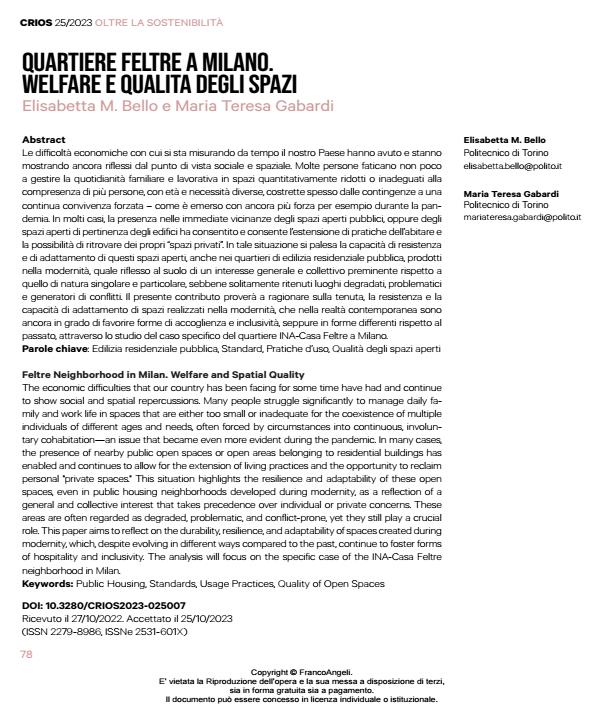Feltre Neighborhood in Milan. Welfare and Spatial Quality
Journal title CRIOS
Author/s Elisabetta M. Bello, Maria Teresa Gabardi
Publishing Year 2025 Issue 2023/25
Language Italian Pages 10 P. 78-87 File size 206 KB
DOI 10.3280/CRIOS2023-025007
DOI is like a bar code for intellectual property: to have more infomation
click here
Below, you can see the article first page
If you want to buy this article in PDF format, you can do it, following the instructions to buy download credits

FrancoAngeli is member of Publishers International Linking Association, Inc (PILA), a not-for-profit association which run the CrossRef service enabling links to and from online scholarly content.
The economic difficulties that our country has been facing for some time have had and continue to show social and spatial repercussions. Many people struggle significantly to manage daily family and work life in spaces that are either too small or inadequate for the coexistence of multiple individuals of different ages and needs, often forced by circumstances into continuous, involuntary cohabitation—an issue that became even more evident during the pandemic. In many cases, the presence of nearby public open spaces or open areas belonging to residential buildings has enabled and continues to allow for the extension of living practices and the opportunity to reclaim personal "private spaces." This situation highlights the resilience and adaptability of these open spaces, even in public housing neighborhoods developed during modernity, as a reflection of a general and collective interest that takes precedence over individual or private concerns. These areas are often regarded as degraded, problematic, and conflict-prone, yet they still play a crucial role. This paper aims to reflect on the durability, resilience, and adaptability of spaces created during modernity, which, despite evolving in different ways compared to the past, continue to foster forms of hospitality and inclusivity. The analysis will focus on the specific case of the INA-Casa Feltre neighborhood in Milan.
Keywords: Public Housing, Standards, Usage Practices, Quality of Open Spaces
Elisabetta M. Bello, Maria Teresa Gabardi, Quartiere feltre a Milano. Welfare e qualita degli spazi in "CRIOS" 25/2023, pp 78-87, DOI: 10.3280/CRIOS2023-025007